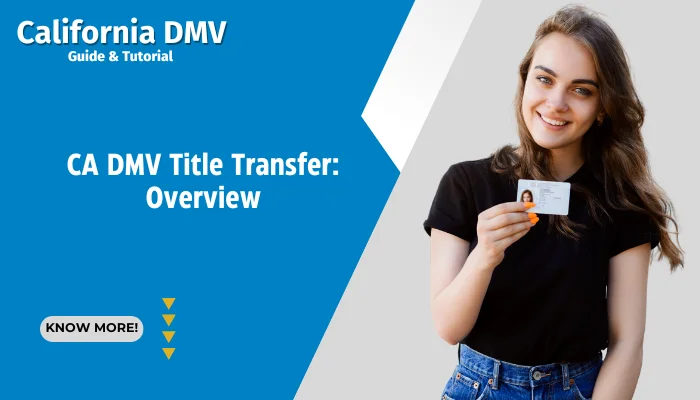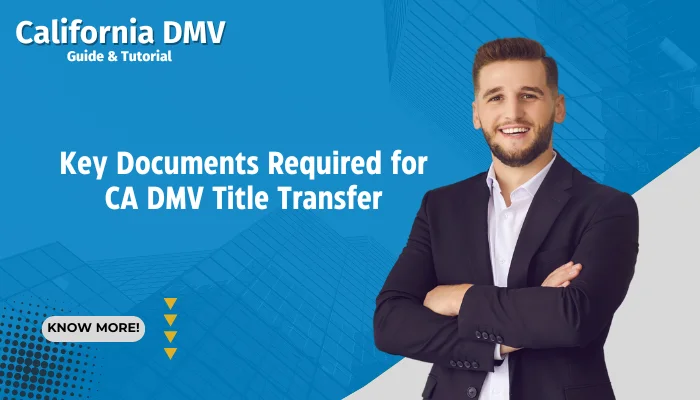This exhaustive guide about CA DMV title transfer will take you through everything one needs to know for an easy process.

We will discuss the steps involved, required documents, fees and offer useful hints to make sure your CA DMV title transfer process is trouble-free.
It is necessary that a person understands the CA DMV title transfer procedure whether he/she wants to buy or sell a car. Let’s begin!

CA DMV Title Transfer: Overview
The term ‘CA DMV title transfer’ refers to the act of transferring the ownership of a vehicle from one party to another in California legally. This occurs each time that a motor changes hands through sales, inheritance as well as gifts among others.
Title transfers must be done correctly according to California Department of Motor Vehicles (DMV) regulations. The main aim behind this is ensuring all transactions are recorded properly and that the new owner assumes full legal responsibility for it.
To facilitate easy CA DMV title transfer, there are specific steps and requirements that must be followed as stipulated by law.
However, depending on situations such as purchasing from either a private individual or dealer or inheriting it may lead some slight changes in these procedures. Nevertheless, fundamental steps never change.
Steps Involved in CA DMV Title Transfer
This process involves several stages which both parties i.e., buyer and seller have to adhere so as to ensure that it becomes legally binding as well documented when transferred. Here’s an outline showing how each step should be taken:
Step 1: Collecting The Required Documents
Prior starting on with CA DMV title transfer, both entities have got some papers they need. The documents typically include:
- The vehicle’s title certificate
- A completed Application for Title or Registration (Form REG 343)
- A smog certification (if required)
- Proof of insurance
- Payment for applicable fees
Step 2: Fill out the Title Certificate
The seller should fill in the “Release of Ownership” section on the title certificate. This contains details such as buyer’s information, date of purchase, selling price and reading on odometer at that point. The title certificate must be signed by both parties i.e., buyer and seller.
Step 3: Submitting Application for Title or Registration
The Application for Title or Registration i.e., Form REG 343 must be filled by the buyer who should then take it to DMV. The new owner’s personal information, vehicle details and any lienholders can be found here.
Step 4: Making Payments
When it comes to CA DMV title transfer form, it is up to the buyer to pay all the necessary fees. These charges might include transfer fees, use taxes as well as other pending registration fee. It is essential for one to consult with a local DMV office since they do determine what has been charged currently.
Step 5: Obtain a Smog Certification
In order to complete CA DMV title transfer sometimes, buyers have been known to need a smog certification. Older vehicles that are not exempted will need this if they were four years old or more. Seller will usually provide valid smog certificates during sale.
Filling Out Forms and Paying The Fees
Once all papers have been completed and payments made, all this can be deposited to DMV by the buyer.
The same can be done in person at an office of the department of motor vehicles (DMV) or through mail or even online via their web site. DMV will process the application and give a new Title Certificate in the name of the buyer.
Following these steps as well as knowing them will help you successfully achieve CA DMV title transfer. Transfer delays and problems will not arise if documentation is right and fees paid for.

Key Documents Required for CA DMV Title Transfer
In CA DMV title transfer, having proper documents is vital to facilitate a smooth operation process. Failure to provide some documents may lead to delays or denial of title transfer request. The following are some essential documents that are necessary to have during a CA DMV title transfer.
- Vehicle Title Certificate: The pink slip as it is commonly known, is the most important paper needed when doing a CA DMV title transfer form. It confirms vehicle ownership and contains key details about car such as vehicle identification number (VIN), make, model, year etc. Both seller and buyer must fill out the Title Certificate during the process.
- Application for Title or Registration (Form REG 343): Another important document required for CA DMV title transfer is Application for Title or Registration (Form REG 343).
This form provides information concerning both vehicle itself, new owner plus any lien holders on it. - Smog Certification: During CA DMV registration procedure some cars might need smog certification test results hence they should pass through it before changing hands from one person to another within CA state lines only. This certificate shows that the vehicle complies with California’s emission standards.
In most cases, a valid smog certificate is required by the seller at the time of sale. But if the vehicle is being sold “as is,” so before the title transfer can be completed, you might have to get a smog certification. - Bill of Sale: Though not always compulsory, it is good that you prepare a bill of sale when dealing with CA DMV title transfer. This document serves as an evidence for purchase and confirms agreed price between parties involved in transaction.
- Proof of Insurance: For any CA DMV title transfer, the buyer has to show proof of insurance. This will indicate that the new owner has sufficient vehicle liability coverage in California.
- Payment for Fees: Various costs must be paid to undertake CA DMV title transfer. These charges may include but are not limited to some transfer fees, use tax or late registration fee among others you could visit dmv.ca.gov for more information on this matter or consult your local office where payments would normally be made.
Having these documents ready ensures that there are no hiccups during the “CA DMV title transfer” process; double check everything before you submit it to DLG.
Fees and Costs for Transferring a Title in the CA DMV
To make CA DMV title transfer smooth and trouble-free, you must know what it costs. Different fees may apply depending on various factors like the type of vehicle, its worth and where it is being transferred from. Let us look into some typical fees and charges that come with a CA DMV title transfer.
- Transfer Fees: For each CA DMV title transfer, there is the basic fee which is mandatory. This fee caters for administrative costs related to processing the change in ownership.
The current charge for this service is about $15 but all depends on whether there are updates by the department of motor vehicles. - Use Tax: Apart from paying for the transfer fee, buyers may also have to remit use taxes. Usually, these are calculated based on how much the buyer paid for the car as well as where he lives at present. It is also important to check what rate applies in your specific county because they differ.
- Smog Transfer Fee: In case CA DMV title transfer form requires a smog certification; then it might attract a smog transfer fee too. Primarily, this cost accounts for changing ownership information in relation to smog certificates from seller to purchaser.
An updated version of this document cites that approximately $8 has been given as an estimate of how much you could possibly spend on this transaction today. - Registration Fees: Sometimes additional registration fees can be levied during CA DMV title transfer based on how registration went while you were still using your car back home before relocation began As such renewal or late fees can be due or due to amounts overdue.
Therefore outstanding dues need to be paid before completion of this process after checking status of your vehicle’s records. - Penalty Fees: Taking more time than specified will call for giving out penalty fees because one failed meeting that time deadline for completing this CA DMV title transfer.
The law gives buyers in California only 10 days to ensure that the ownership of the vehicle is transferred from the previous owner to them. - Miscellaneous Fees: Other CA DMV title transfer form may have further costs like duplicate certificate of title, releasing a lien or special processing requests to be made.
All these additional outlays need to be known by consulting with officials at Department of Motor Vehicles in order to make correct estimates.
Understanding different fees and charges related with a CA DMV title transfer aids in budgeting accordingly and avoiding surprises throughout. Therefore ensure you go through the most recent fee listing with DMV and any pending payments before making an official transaction for your titles.
Here’s the blog article with important NLP keywords bolded and formatted with appropriate headings, lists, and structure:
Title Transfer Issues in the California Department of Motor Vehicles
Some issues are common in the CA DMV title transfer process despite its apparent simplicity. Familiarity with these setbacks can assist to avoid possible pitfalls.
- Incomplete Paperwork: Typical among them is incomplete paperwork. Non existing signatures, inaccurate information or unfinished forms might slow down the exercise.
- Smog Certificate Absent: Failure to produce a smog certification when the vehicle is over four years old will prevent you from completing a CA DMV (dmv.ca.gov) title transfer process. If need be, ensure this paper is available for use.
- Fees that have not been Paid: Any outstanding fees like unpaid traffic fines or registration can delay the CA DMV title transfer form. Clear all dues and settle old accounts before you initiate a transfer.
Understanding of some typical problems during the CA DMV title transfer process will enable one to be well prepared and avoid any delays that may occur. Make sure that all documents are filled out completely and search for needed papers as well as non-paid bills.
Tips for a Smooth CA DMV Title Transfer
Efficient completion of paperwork is necessary for smooth transitioning of titles within CA DMV offices. Find useful tips below:
- Proofread Documents Again: Ensure that all forms are complete and true before they go forward. This could slow down everything if it does not contain signatures or has incorrect facts.
- Book an appointment: Make an appointment with your local DMV office if they accept them, this way you can get more attention to help you through your CA DMV title transfer form.
- Make Use of Internet Services: To facilitate transaction without going there in person California motor vehicle department provides online alternatives for a few specifics concerning car ownership change such as titles.
These should be availed once you learn about them so as expedite what would take time in case one decides on physical meetings.
These pointers will facilitate quick transition between title holders at CA DMV. Planning and utilization of all available resources may make this procedure faster and more snappy.
Conclusion
The process of transferring a CA DMV title is necessary when a car’s ownership needs to change hands legally within California.
This article explains how one can buy, sell, inherit, gift or lease any automobile by knowing its procedure as well as requirements that should be followed leading towards successful completion of such transactions.
Consequently, all necessary papers must be carried along payment made against the currency given while following instructions according the situation available in order for this CA DMV title transfer to become fruitful.
